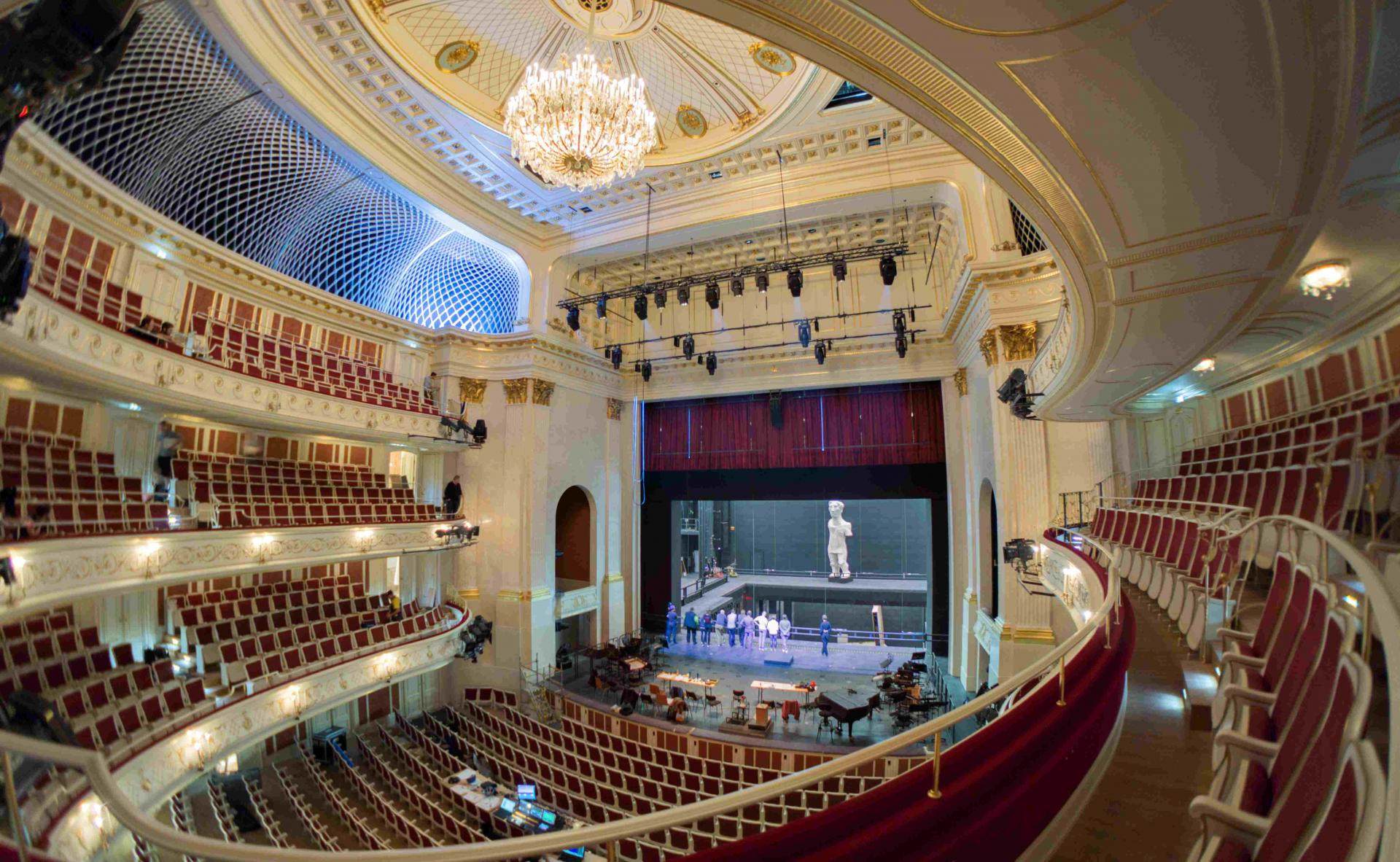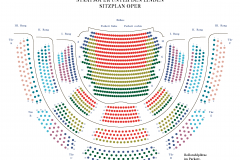The Excursions of Mr. Brouček
Mo | Tu | We | Th | Fr | Sa | Su |
OPERA IN TWO PARTS (1920)
MUSIC FROM Leoš Janáček
TEXT FROM Leoš Janáček
At his local Prague bar, the landlord Brouček has a reputation for being a petty philistine. He himself is tired of dealing with insolvent renters and dreams of getting away from all the daily hassle. When one night he has had one beer too many, his wish comes true in a miraculous way with two fantastic excursions: first, Brouček lands on the moon inhabited by a strange, overly intellectual society of artists. Then he finds himself in medieval Prague, stuck between the fronts of a battle between the confessions, and is about to go to war on the side of the Hussites.
In his satirical opera The Excursions of Mr. Brouček, Leoš Janáček was able to continue developing his advanced musical language and to enrich it with complex comedy. Conducted by Simon Rattle, this new production of this rarely performed work by Canadian director Robert Carsen will bring the eventful history of the city of Prague back to life.
Synopsis
Scene 1
Mr. Matěj Brouček is a rather unkempt drunken landlord in late 19th-century Prague. On a moonlit night in 1888, Mr. Brouček stumbles down Vikárka street after a drinking binge at the Hradčany tavern. In his impaired state, he encounters Málinka. She is upset and dramatically suicidal after discovering that her lover, Mazál (who happens to be one of Brouček's tenants) has been cheating on her. In an ill-advised attempt to calm Málinka, Brouček agrees to marry her. He quickly realizes the error in this and retracts his offer, leaving Málinka to return to her bohemian lover. Brouček decides he has had enough of this stress and dreams of a more relaxed life on the Moon.
Scene 2
Brouček is quickly disillusioned by what he finds in his lunar paradise. He "lands" in the middle of an avant-garde colony of lunar artists and intellectuals, whom the uncultured Brouček clearly despises. He finds himself in the home of an avant-garde artist, Blankytny (a parallel character to Mazál). Blankytny sings a heartfelt ode of platonic love to the lunar maiden, Etherea. This signals the arrival of Etherea and her ‘sisters’ who commence with a song preaching the benefits of a healthy lifestyle. Ironically, Brouček catches the eye of the maiden, who becomes instantly infatuated with the exotic stranger. She whisks him away aboard mythical Pegasus, leaving behind Blankytny in disbelief and despair.
Scene 3
Etherea and Brouček land in the Lunar Temple of the Arts, where a group of inhabitants has gathered. They are immediately startled and frightened at the sight of Brouček, but soon see him as the latest vogue. The locals proceed to present Brouček with the latest in lunar art and treat him to a "meal" of sniffing flowers. Brouček is not at all pleased with this display of art, nor is he nourished by the fragrances. He is soon caught sneaking a bite of pork sausage; the crowd quickly turns on him, and he is forced into a furious escape aboard Pegasus. As he flees, the lunar artists sing praises to art.
Scene 4
As the Moon scene transforms back into the tavern courtyard in Prague, Mazál and Málinka are returning home, and the artists are enjoying a final drink. A young waiter laughs at the drunken Brouček who is being carried off in a barrel. Málinka is apparently recovered from her turmoil, as she and Mazál sing a duet of their love for each other.
Program and cast
Language: In czech language with german and english surtitles
Recommended age: 14 years and older
Insight before the premiere on 11th march 2025
CAST
MUSICAL DIRECTOR: Simon Rattle
DIRECTOR: Robert Carsen
SET DESIGN: Radu Boruzescu
COSTUMES: Annemarie Woods
CHOREOGRAPHY: Rebecca Howell
LIGHT: Robert Carsen, Peter van Praet
CHORUS MASTER: Gerhard Polifka
DRAMATURGY: Patricie Částková, Elisabeth Kühne
VIDEO: Dominik Žižka
MATĚJ BROUČEK: Peter Hoare
MAZAL, BLANKYTNÝ, PETŘÍK: Aleš Briscein
SAKRISTAN, LUNOBOR, DOMŠÍK VON DER GLOCKE: Gyula Orendt
MÁLINKA, ETHEREA, KUNKA: Lucy Crowe
WÜRFL, ČAROSKVOUCÍ, SCHÖFFE: Carles Pachon
HILFSKELLNER, WUNDERKIND, STUDENT: Clara Nadeshdin
KEDRUTA: Natalia Skrycka
DICHTER, OBLAČNÝ, VACEK: Arttu Kataja
MALER, DUHOSLAV, VOJTA: Stephan Rügamer
KOMPONIST, HARFOBOJ, MIROSLAV: Linard Vrielink
SVATOPLUK ČECH: Taehan Kim
STAATSOPERNCHOR
STAATSKAPELLE BERLIN
State Opera Unter den Linden
Staatsoper Unter den Linden is one of Berlin's most prestigious opera houses, with a rich history and significant cultural impact.
History:
The Staatsoper Unter den Linden was originally built between 1741 and 1743, under the direction of architect Georg Wenzeslaus von Knobelsdorff. It was commissioned by Frederick II of Prussia and was initially named the Königliche Oper (Royal Opera). The opera house has undergone several renovations and reconstructions, notably after World War II damage. It reopened in 1984, following a major renovation.
Construction:
The original design was characterized by its Baroque style, featuring an elegant façade and a grand entrance. The building was reconstructed in the 1950s and 1980s, maintaining its classical exterior while modernizing the interior. The façade features a classic portico with six Corinthian columns and a prominent central pediment.
Interior:
The interior is known for its opulent and classical design. The auditorium is renowned for its acoustics and grandeur, with luxurious velvet seats and elaborate decorations. The stage and seating areas have been updated to meet modern performance standards while preserving historical aesthetics.
Concerts and Performances:
The Staatsoper Unter den Linden hosts a variety of performances, including operas, orchestral concerts, and ballet. It is home to the Staatskapelle Berlin, one of Germany's leading orchestras. The opera house is celebrated for its high-quality productions and its role in Berlin’s vibrant cultural scene.
JOURNEY
The Staatsoper Unter den Linden has completely barrier-free access due to its excellent public transport connections.
ADDRESS: Unter den Linden 7; 10117 Berlin
SUBURBAN RAILWAY
S+U Friedrichstraße (S1, S2, S5, S7, S25, S75)
SUBWAY
Hausvogteiplatz (U2)
Museumsinsel (U5)
Stadtmitte (U2, U6)
Unter den Linden (U5, U6)
BUS
Staatsoper (100, 245, 300)
Unter den Linden/Friedrichstraße (100, 147, 245, 300, N6)
PARKING
Q-PARK parking garage Unter den Linden/Staatsoper
Bebelplatz, 10117 Berlin
There are five electric charging stations in the parking garage. Further information can be found here.
The underground car park on Bebelplatz offers disabled parking spaces and direct access to the opera house. On entering the car park between 5.30pm and 11.30pm, the maximum parking fee is €7. To use this tariff, enter your parking ticket in one of the pay machines and the message »Theatertarif« will appear on the display. Please note that it is not possible to use the tariff if you enter the car park before 5.30pm. so it will not be shown on the display. TIP: If you pay the theatre tariff at the pay machine before the event, you can avoid unnecessary waiting after the show.

 EN
EN DE
DE IT
IT FR
FR ES
ES RU
RU JP
JP RO
RO
 Seating plan
Seating plan 